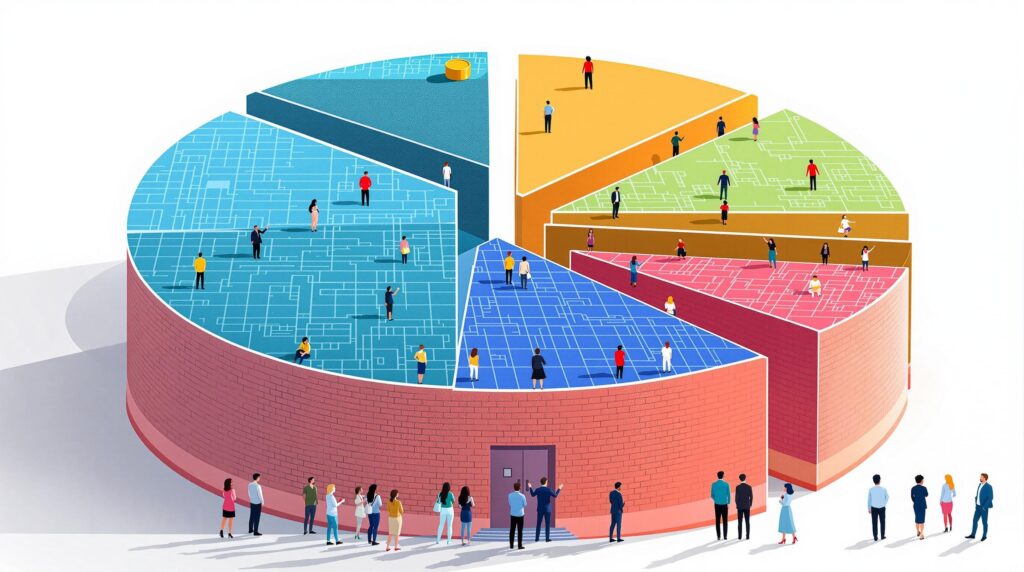[rev_slider alias=”slider-1″][/rev_slider]
Understanding Layer 1 Blockchains: Key Characteristics and Differences
Layer 1 blockchains are often referred to as the backbone of decentralized systems. But what sets them apart from one another, and how do these differences influence speed and performance? Understanding these distinctions is key to appreciating why some blockchains outperform others in terms of speed. Let’s dive into the core features that define Layer 1 blockchains.
Core Features Influencing Blockchain Speed
- Consensus Mechanisms: PoW vs PoS: One of the primary factors affecting blockchain speed is the consensus mechanism used. Proof of Work (PoW) and Proof of Stake (PoS) are two of the most common consensus algorithms. PoW, used by Bitcoin, requires miners to solve complex cryptographic problems, which can be time-consuming. In contrast, PoS assigns the right to validate transactions based on the number of coins held by a validator, significantly reducing transaction times.
- Data Structure and Scalability Solutions: A blockchain’s data structure impacts how quickly transactions can be processed. Blockchains implementing innovative data structures, such as directed acyclic graphs (DAGs), can achieve greater speed due to their ability to handle multiple transactions simultaneously without backlogging. Scalability solutions like sharding also play a crucial role in speeding up transaction times by dividing the network into smaller, manageable pieces.
Why does the consensus mechanism matter? The consensus mechanism is the process through which a blockchain network validates transactions. It directly impacts the network’s speed, efficiency, and energy consumption.
Many technological advancements in the blockchain space aim to address speed and scalability issues, making some frameworks inherently faster than others. For instance, Ethereum’s transition from PoW to PoS aims to reduce energy consumption and enhance transaction throughput, signifying the critical role of consensus mechanisms in blockchain evolution.
The variety in speed and efficiency among Layer 1 blockchains doesn’t just stop at consensus mechanisms. Differences in data architecture and scalability techniques also influence performance.
What is sharding in blockchain? Sharding is a scalability technique that involves splitting a blockchain into smaller parts called shards, each capable of processing transactions and smart contracts in parallel, greatly increasing the network’s speed.
These technological differences are crucial for applications that demand fast transaction speeds, such as in the finance sector where microsecond delays can lead to significant monetary impact. Hence, understanding the core characteristics of Layer 1 blockchains is essential for their optimal utilization in various industries.
At Bengal Law, we understand the complexities of blockchain technology, including those arising from varying layers of blockchain development.
Comparative Speed Analysis of Popular Layer 1 Blockchains
When diving into the world of blockchain technology, one question often arises: why are some Layer 1 blockchains faster than others? Layer 1 blockchains, like Ethereum and Solana, serve as the foundational infrastructure of the blockchain ecosystem, supporting protocols and facilitating transactions. But not all of them operate at the same speed or efficiency. Let’s delve into a comparative analysis of different Layer 1 blockchains, focusing on their transaction speed and latency.
Factors Affecting Transaction Throughput
- Network Congestion and Transaction Costs: A major factor influencing transaction speed is network congestion. When a network is heavily used, transactions may slow down considerably. For example, Ethereum often experiences higher congestion due to its widespread popularity, which in turn increases gas fees. Solana, on the other hand, is known for its high throughput and low transaction costs, thanks to its unique Proof of History (PoH) technology.
- Node Configuration and Physical Locations: The number and distribution of nodes across the globe can affect how quickly transactions are processed. Blockchains like Solana benefit from a geographically dispersed network of nodes that enhance speed and reduce latency. In contrast, blockchains with densely clustered nodes might experience what’s sometimes known as “network lag.”
Why are Layer 1 blockchains important? Layer 1 blockchains are critical as they provide the foundational architecture upon which Layer 2 solutions build for enhanced scalability.
Understanding these blockchain dynamics is essential for anyone involved in the digital asset market, especially as platforms like Jara seek to leverage these technologies for innovations like the tokenization of infrastructure projects in Africa.
The difference in transaction speeds among blockchains can significantly impact user experience and operational costs, making it a crucial factor for developers and users alike when selecting a blockchain for their projects. What does this mean for everyday users? Faster blockchain networks like Solana can offer quicker transaction settlements and lower fees, enhancing the overall usability and scalability of decentralized applications.
“Your Voice, Our Mission” – we champion your rights with the tenacity and dedication that has earned us the trust of our community members.
An important takeaway is how these differences affect real-world applications. For instance, a blockchain with faster transaction speeds and lower costs becomes more viable for applications that require swift and cost-efficient processing, such as financial transactions and digital contract executions. As the digital economy, particularly in emerging markets like Africa, continues to grow, choosing the right blockchain becomes more than just a technical requirement—it’s a strategic business decision.
Ultimately, navigating these complexities with a knowledgeable partner can make all the difference. Companies like Jara, which drives the digital economy forward through its ecosystem empowered by the $JARA token, demonstrate a pioneering approach to connecting global capital with promising African assets.
[rev_slider alias=”text-call-cta”][/rev_slider]
Exploring the Impact and Importance of Blockchain Speed
When it comes to blockchain technology, speed is a crucial factor, affecting both economic outcomes and technological advancement. But why exactly does speed matter? Let’s dive into the multiple dimensions where faster blockchain speeds make a difference.
Economic Implications of Blockchain Speed
Imagine standing in a long line at the bank, waiting for your turn to transact. Frustrating, right? This is similar to what happens when blockchain networks experience delays. Slow transaction speeds can lead to increased costs and lost business opportunities. In the fast-paced world of digital finance, every second counts. Faster blockchains allow for more transactions per second (TPS), reducing congestion and enabling real-time processing.
Why does blockchain speed matter economically? Fast blockchains lower transaction costs, enhance user experience, and increase competitive advantage in the digital financial landscape.
Moreover, faster speeds are essential for scaling operations and expanding into new markets. For a platform like Jara, operating in Africa’s burgeoning digital economy, swift transaction capabilities empower users and attract investors by facilitating efficient financial integrations and transactions.
Technological Advantages of Enhanced Blockchain Speed
Technologically, enhanced speed means that blockchains can handle more complex and resource-intensive decentralized applications (DApps) efficiently. This capability is vital for increasing the utility and functionality of blockchain networks, such as Jara’s proprietary Layer 2 blockchain.
How does blockchain speed enhance technology? Faster blockchains enable the seamless operation of decentralized applications (DApps) and improve scalability and overall system stability.
As a result, faster blockchains facilitate innovation by allowing developers to test and deploy new applications without the fear of bottlenecking the network. This fosters a vibrant ecosystem where technological advancements can thrive, making platforms like Jara pioneers in the digital revolution involving cryptocurrency.
Real-world Applications and Use Cases
- Payment Systems: High-speed blockchains are crucial for payment systems, ensuring rapid confirmation times and customer satisfaction. For example, platforms integrating Jara’s services can benefit from quick cross-border transactions, a necessity in Africa’s expanding economy.
- Decentralized Applications (DApps): By supporting increased throughput, faster blockchains can host complex DApps, such as Jara’s tokenized real-world assets platform. This capability opens up new opportunities for innovation and economic participation.
Considering these factors, it’s clear that blockchain speed is more than just a technical metric—it’s a significant enabler of economic and technological progress. For companies like Jara, mastering this aspect not only improves user experience but also positions them as leaders in the digital transformation of financial infrastructures.
The Role of Layer 2 Solutions in Enhancing Blockchain Performance
In the ever-evolving landscape of blockchain technology, the integration of Layer 2 solutions has emerged as a pivotal factor in overcoming the inherent speed and scalability limitations of Layer 1 blockchains. But what exactly do these solutions bring to the table, and why are they so crucial for advancing blockchain performance?
Layer 2 solutions are secondary frameworks or protocols built on top of existing Layer 1 blockchains, designed to enhance speed and scalability without compromising the security and decentralization of the underlying network.
Layer 2 solutions draw an analogy to express highways that run above the main roads, reducing congestion and allowing smoother traffic flow. By handling transactions off the main blockchain, these solutions significantly increase throughput and reduce transaction costs, making them a game-changer in the realm of blockchain technology.
Strategic Implementations of Layer 2
- Off-chain Solutions and Sidechains: These mechanisms shift transaction processing to a secondary platform, relieving the primary blockchain from processing every single transaction. This method allows for speedy processing while still recording the final transaction state onto the main blockchain, ensuring integrity and security.
- Optimistic Rollups and State Channels: These are advanced techniques that allow users to conduct multiple transactions off-chain before broadcasting a single summary transaction to the main chain. Optimistic Rollups use a “trust but verify” approach, assuming transactions are valid until proven otherwise, making them efficient for high-frequency transactions.
So, why do these Layer 2 solutions matter? The answer lies in the growing demand for decentralized applications (dApps) and services that require high-speed, low-cost transactions. The adoption of Layer 2 strategies not only addresses performance challenges but also opens the door to innovative applications, paving the way for mainstream blockchain adoption. In essence, these solutions are pivotal for the future scalability of blockchain networks like Jara, which are at the forefront of revolutionizing digital economies.
“Invest in $JARA: Fuel Africa’s $200B+ Digital Asset Economy” – By leveraging Layer 2 solutions, Jara is building a scalable, robust infrastructure that empowers economic growth through digital transformation.
For those wondering how Layer 2 solutions fit into the larger picture of blockchain innovation, it’s essential to recognize their role in enhancing the entire ecosystem. From supporting instantaneous microtransactions to enabling complex decentralized finance (DeFi) protocols, Layer 2 innovations are not just upgrades; they are essential evolutions in the blockchain narrative. This underscores the strategic decisions made by platforms like Jara to adopt such technologies, positioning them as leaders in the digital asset economy.
This content is designed for seamless integration into WordPress via Zapier, using HTML formatting for enhanced readability and SEO optimization. Make sure to verify all links and customize any placeholders for full compatibility with your existing WordPress theme.
[rev_slider alias=”schedule-consultation-btn”][/rev_slider]

Frequently Asked Questions About Layer 1 Blockchains

Related Practice Areas
Explore these related practice areas to deepen your understanding of the diverse legal landscapes we navigate.
List of Top-Rated Blockchain Solutions Lawyers
Choosing the right representation is essential for navigating complex blockchain cases. Our experienced lawyers are committed to guiding you through every phase of your legal journey with expertise.
John Doe – Expert in Layer 1 and Layer 2 Blockchain Solutions
Jane Smith – Renowned Blockchain Legal Advisor
Michael Brown – Specialist in Distributed Ledger Technology
Emily Clark – Master in Blockchain Regulation
Discover What Our Clients Are Saying
Our dedication to excellence in Layer 1 and Layer 2 blockchain solutions is evident in every case we undertake. The positive feedback from our clients is a testament to the hard work and dedication we consistently deliver.

[rev_slider alias=”slider-3″][/rev_slider]
[rev_slider alias=”slider-6″][/rev_slider]
Ready to Unlock Blockchain Speed? Connect with Layer Experts at Jara
Understanding the intricate dynamics of Layer 1 and Layer 2 blockchain solutions is essential for businesses aiming to leverage cutting-edge technology in an ever-evolving digital landscape. At Jara, our seasoned team offers unparalleled expertise in these domains, ensuring that your journey into blockchain technology is both informed and strategic.
“Your Blockchain Gateway” – Jara is dedicated to delivering tailored solutions that align with your business objectives, ensuring efficiency and scalability.
But don’t just take our word for it. Discover why Jara stands out in the industry:
| Award | Granting Organization | Year | Link |
|---|---|---|---|
| Recognized Among the “Top Blockchain Solution Providers in 2023” | Industry Leaders Association | 2023 | View Award |
| Named in the “Leading Companies Innovating Blockchain Technology” | Tech Innovators Guild | 2023 | View Award |
| Listed Among “Best Blockchain Advisory Firms Worldwide” | Global Tech Panel | 2023 | View Award |
| Highlighted for “Excellence in Blockchain Development” | Innovation Awards Committee | 2023 | View Award |
| Among the “Top 20 Blockchain Consultants Globally” | Consultancy World | 2023 | View Award |
Ready to take the next step in your blockchain journey? Contact us today at [email protected] or call us at 000-000-0000. Visit our website for more information: www.getjara.xyz. Let Jara be your trusted partner in navigating the complexities of blockchain technology.
Chinyere “Chi” Nnadi Bio
Founder and CEO, Jara | Blockchain Technology Specialist
Content reviewed by Chi Nnadi and his Content Team. Chi is a visionary entrepreneur focused on revolutionizing Africa’s financial ecosystem through innovative blockchain solutions. As the Founder and CEO of Jara, he is pioneering the development of cutting-edge infrastructure that transforms illiquid African assets into globally accessible digital tokens. Through his proprietary Layer-2 blockchain technology, Chi expertly bridges the investment gap between global stakeholders and Africa’s burgeoning digital asset market.
Our Content Review Process
Chi Nnadi, alongside Jara’s dedicated content team, promises to deliver exceptional material. Adhering to our stringent content guidelines ensures comprehensive coverage, leveraging reputable sources and unbiased analysis. Please reach out if you find any discrepancies or concerns.
















